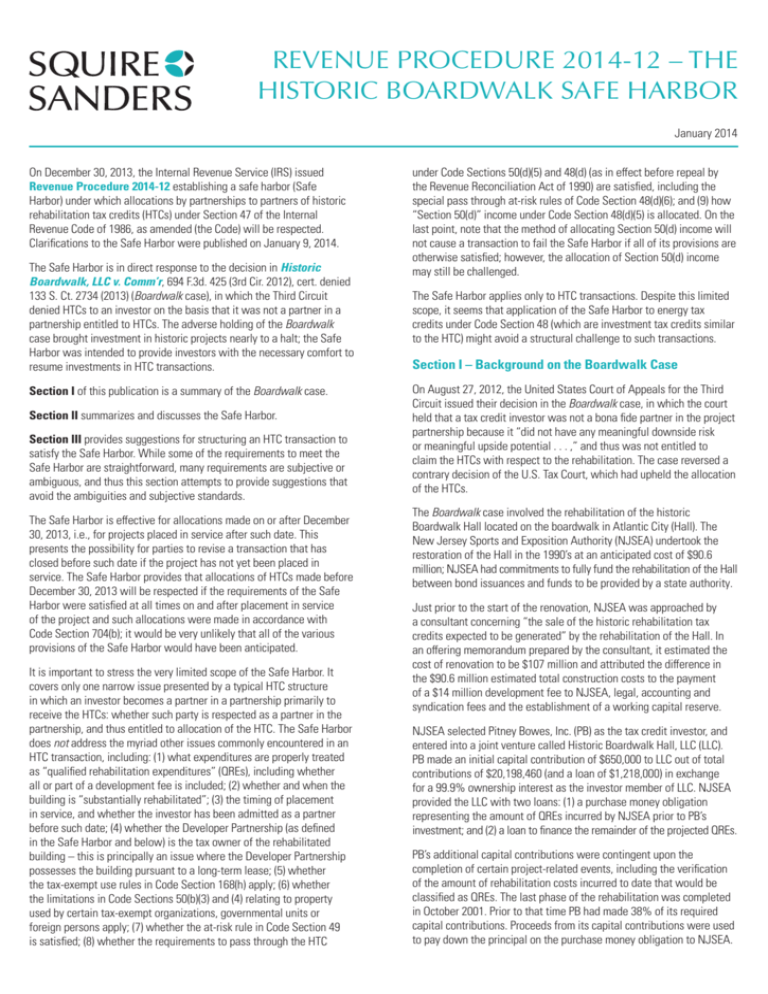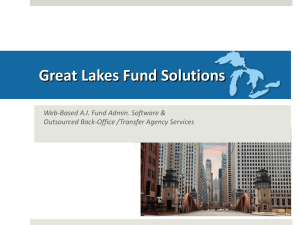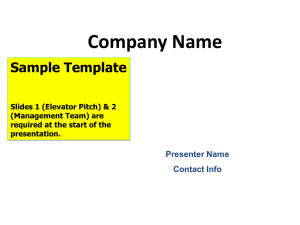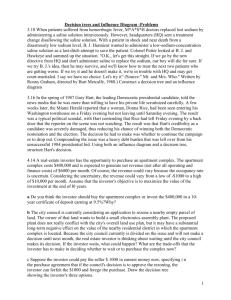
REVENUE PROCEDURE 2014-12 – THE
HISTORIC BOARDWALK SAFE HARBOR
January 2014
On December 30, 2013, the Internal Revenue Service (IRS) issued
Revenue Procedure 2014-12 establishing a safe harbor (Safe
Harbor) under which allocations by partnerships to partners of historic
rehabilitation tax credits (HTCs) under Section 47 of the Internal
Revenue Code of 1986, as amended (the Code) will be respected.
Clarifications to the Safe Harbor were published on January 9, 2014.
The Safe Harbor is in direct response to the decision in Historic
Boardwalk, LLC v. Comm’r, 694 F.3d. 425 (3rd Cir. 2012), cert. denied
133 S. Ct. 2734 (2013) (Boardwalk case), in which the Third Circuit
denied HTCs to an investor on the basis that it was not a partner in a
partnership entitled to HTCs. The adverse holding of the Boardwalk
case brought investment in historic projects nearly to a halt; the Safe
Harbor was intended to provide investors with the necessary comfort to
resume investments in HTC transactions.
Section I of this publication is a summary of the Boardwalk case.
Section II summarizes and discusses the Safe Harbor.
Section III provides suggestions for structuring an HTC transaction to
satisfy the Safe Harbor. While some of the requirements to meet the
Safe Harbor are straightforward, many requirements are subjective or
ambiguous, and thus this section attempts to provide suggestions that
avoid the ambiguities and subjective standards.
The Safe Harbor is effective for allocations made on or after December
30, 2013, i.e., for projects placed in service after such date. This
presents the possibility for parties to revise a transaction that has
closed before such date if the project has not yet been placed in
service. The Safe Harbor provides that allocations of HTCs made before
December 30, 2013 will be respected if the requirements of the Safe
Harbor were satisfied at all times on and after placement in service
of the project and such allocations were made in accordance with
Code Section 704(b); it would be very unlikely that all of the various
provisions of the Safe Harbor would have been anticipated.
It is important to stress the very limited scope of the Safe Harbor. It
covers only one narrow issue presented by a typical HTC structure
in which an investor becomes a partner in a partnership primarily to
receive the HTCs: whether such party is respected as a partner in the
partnership, and thus entitled to allocation of the HTC. The Safe Harbor
does not address the myriad other issues commonly encountered in an
HTC transaction, including: (1) what expenditures are properly treated
as “qualified rehabilitation expenditures” (QREs), including whether
all or part of a development fee is included; (2) whether and when the
building is “substantially rehabilitated”; (3) the timing of placement
in service, and whether the investor has been admitted as a partner
before such date; (4) whether the Developer Partnership (as defined
in the Safe Harbor and below) is the tax owner of the rehabilitated
building – this is principally an issue where the Developer Partnership
possesses the building pursuant to a long-term lease; (5) whether
the tax-exempt use rules in Code Section 168(h) apply; (6) whether
the limitations in Code Sections 50(b)(3) and (4) relating to property
used by certain tax-exempt organizations, governmental units or
foreign persons apply; (7) whether the at-risk rule in Code Section 49
is satisfied; (8) whether the requirements to pass through the HTC
under Code Sections 50(d)(5) and 48(d) (as in effect before repeal by
the Revenue Reconciliation Act of 1990) are satisfied, including the
special pass through at-risk rules of Code Section 48(d)(6); and (9) how
“Section 50(d)” income under Code Section 48(d)(5) is allocated. On the
last point, note that the method of allocating Section 50(d) income will
not cause a transaction to fail the Safe Harbor if all of its provisions are
otherwise satisfied; however, the allocation of Section 50(d) income
may still be challenged.
The Safe Harbor applies only to HTC transactions. Despite this limited
scope, it seems that application of the Safe Harbor to energy tax
credits under Code Section 48 (which are investment tax credits similar
to the HTC) might avoid a structural challenge to such transactions.
Section I – Background on the Boardwalk Case
On August 27, 2012, the United States Court of Appeals for the Third
Circuit issued their decision in the Boardwalk case, in which the court
held that a tax credit investor was not a bona fide partner in the project
partnership because it “did not have any meaningful downside risk
or meaningful upside potential . . . ,” and thus was not entitled to
claim the HTCs with respect to the rehabilitation. The case reversed a
contrary decision of the U.S. Tax Court, which had upheld the allocation
of the HTCs.
The Boardwalk case involved the rehabilitation of the historic
Boardwalk Hall located on the boardwalk in Atlantic City (Hall). The
New Jersey Sports and Exposition Authority (NJSEA) undertook the
restoration of the Hall in the 1990’s at an anticipated cost of $90.6
million; NJSEA had commitments to fully fund the rehabilitation of the Hall
between bond issuances and funds to be provided by a state authority.
Just prior to the start of the renovation, NJSEA was approached by
a consultant concerning “the sale of the historic rehabilitation tax
credits expected to be generated” by the rehabilitation of the Hall. In
an offering memorandum prepared by the consultant, it estimated the
cost of renovation to be $107 million and attributed the difference in
the $90.6 million estimated total construction costs to the payment
of a $14 million development fee to NJSEA, legal, accounting and
syndication fees and the establishment of a working capital reserve.
NJSEA selected Pitney Bowes, Inc. (PB) as the tax credit investor, and
entered into a joint venture called Historic Boardwalk Hall, LLC (LLC).
PB made an initial capital contribution of $650,000 to LLC out of total
contributions of $20,198,460 (and a loan of $1,218,000) in exchange
for a 99.9% ownership interest as the investor member of LLC. NJSEA
provided the LLC with two loans: (1) a purchase money obligation
representing the amount of QREs incurred by NJSEA prior to PB’s
investment; and (2) a loan to finance the remainder of the projected QREs.
PB’s additional capital contributions were contingent upon the
completion of certain project-related events, including the verification
of the amount of rehabilitation costs incurred to date that would be
classified as QREs. The last phase of the rehabilitation was completed
in October 2001. Prior to that time PB had made 38% of its required
capital contributions. Proceeds from its capital contributions were used
to pay down the principal on the purchase money obligation to NJSEA.
NJSEA provided the following guarantees: (1) to fund all excess
development costs through a completion guaranty; (2) to fund operating
deficits through interest free loans as an operating deficit guaranty; and
(3) to indemnify PB against any loss arising from hazardous materials
on the property including remediation costs through an environmental
guaranty. In addition, the LLC also agreed to provide PB with a typical
tax indemnity covering any recapture of the HTC and audit costs.
The court cited both lack of downside risk and upside potential in its
holding. Following are negative factors that presumably contributed to
the court’s assessment that there was no meaningful downside risk:
Cash flow was distributed first to PB to pay its preferred return and tax
distribution, then to NJSEA to repay interest and principal on its loans
and amounts advanced pursuant to any operating deficit guaranty,
and only then the balance to PB and NJSEA in accordance with their
respective percentage interests.
•PB did not bear any construction risk due to the unlimited
completion guaranty and the timing of the investor’s capital
contributions;
NJSEA and PB entered into “put” and “call” options whereby NJSEA
had the right to call PB’s membership interest in LLC any time during
the 12 month period starting 60 months from the placement in
service date. If NJSEA did not exercise its call option, PB had the
right to exercise its put option at any time during the 12 month period
beginning 84 months from the placement in service date. Both the put
and call price was set at the greater of the fair market value of PB’s
membership interest and any accrued and unpaid preferred return due
to PB. In addition to a purchase option and a put option, there was also
a “consent option” whereby NJSEA could purchase PB’s interest for an
amount equal to the net present value of any unrealized tax benefits
and expected cash flow through the end of the credit period. PB could
compel NJSEA to purchase its interest in the event of an NJSEA default.
NJSEA was required to obtain a guaranteed investment contract (GIC)
in an amount reasonably satisfactory to secure the repurchase of PB’s
interest. The amount of the GIC needed to be sized to repay PB’s loan
plus accrued but unpaid interest and PB’s annual priority distributions.
Prior to the closing of PB’s commitment, the LLC engaged an accounting
firm with national experience in HTC transactions to prepare financial
projections in connection with PB’s investment. The projections for
the project were changed several times, often without sufficient
support, with the ultimate appearance that they were being artificially
massaged solely to support the tax position. The initial projections
showed a significant net operating loss for the first five years. Those
projections were revised by removing utility expenses, which resulted
in significant net operating income over the same period. When
the accountants pointed out that there was no cash flow to pay the
project debt, they were instructed by a consultant to add several new
sources of revenue, specifically “naming rights,” parking revenue and
net concession revenue, apparently without any evidence that such
revenue was actually contemplated. The accountants also (without any
stated rationale) increased the trending of the income to 3.5%, but left
the trending of the expenses at 3%. The final projections estimated net
operating income for the first five years of $9.9 million, but in reality
there were operating deficits totaling $10.5 million for that period.
•The 3% preferred return was assured because it was the floor
for the purchase and put options, which were secured by a GIC
purchased with PB’s equity;
•Operating deficits were guaranteed;
•PB bore no environmental risk due to the environmental guaranty;
and
•PB was assured of receiving its capital back in the form of the tax
credit or an indemnity payment in lieu thereof, and of receiving its
3% preferred return, whether the project was a success or a failure.
In addition to the limited downside risk assumed by PB, it had virtually
no upside potential. The court stated that PB’s “avoidance of all
meaningful downside risk in [LLC] was accompanied by a dearth of
any meaningful upside potential.” Following are factors cited for that
conclusion:
•PB was entitled to 99.9% of residual cash flow, but as the court
noted, the LLC’s “own rosy financial projections from 2007 to
2042 … forecasted no residual cash flow available for [residual]
distribution.” This was because cash flow was first used to pay the
investor its preferred return and then to pay debt service and repay
the operating deficit loan.
•Although in form PB could receive the fair market value of its
interest if either the call option or put option were exercised, there
was also a “consent option” whereby NJSEA could purchase
PB’s interest for an amount equal to the net present value of any
unrealized tax benefits and expected cash flow through the end of
the credit period.
The court therefore held that PB was not a bona fide partner in the LLC
because it had no meaningful downside risk or upside potential.
A fuller summary of the Boardwalk case is available online.
Section II – Summary and Discussion of Safe Harbor
For purposes of this Section II, terms defined in the Safe Harbor are
used, viz., “Investor” refers to a tax credit-motivated investor member
in a Developer Partnership or Master Tenant Partnership. A “Developer
Partnership” is the entity, customarily a limited liability company
that is treated as a partnership for tax purposes, that owns and
rehabilitates the building. A “Master Tenant Partnership” is an entity,
again customarily organized as a limited liability company, that leases
the project pursuant to a long-term master lease from the Developer
Partnership, in a transaction in which the Developer Partnership elects
to pass through the HTC pursuant to Code Section 50(d)(5). The term
“Principal” refers to a managing member in a Developer Partnership
and/or a Master Tenant Partnership, which would customarily be the
developer or an affiliate of the developer. All of these terms include
related parties, as defined in Code Sections 267(b) and 707(b)(1).
1. P
rohibition on Investor investing in Developer Partnership if
Investor receives HTC through a Master Tenant Partnership.
If the transaction is structured as a pass through deal, whereby
the Investor is a member in the Master Tenant Partnership, the
Investor cannot also hold an interest in the Developer Partnership.
The Master Tenant Partnership is, however, permitted to hold
an interest in the Developer Partnership (and thus the Investor
can have an indirect interest in the Developer Partnership). The
percentage interest that the Master Tenant Partnership may hold in
the Developer Partnership is not specified, but it would be prudent
to limit the investment to less than a 50% profits interest.1
It is unclear what potential abuse this prohibition is attempting
to foreclose, or why that abuse is not present with the indirect
investment allowed, but since dual investments in pass through
transactions would be very uncommon, this proscription is unlikely
to be of concern.
The Safe Harbor permits, as an exception, the Investor to invest in
both the Master Tenant Partnership and the Developer Partnership
pursuant to a separately negotiated arrangement, with “twinned”
investments in New Markets Tax Credit or Low-Income Housing
Tax Credit transactions mentioned as examples, although no further
guidance on this point is given.
2. M
ember’s Minimum Interests in Developer Partnership
and/or Master Tenant Partnership; Flip Permitted.
a.
Minimum 1% interest for Principal. The Principal must
have a minimum 1% interest in each material item of the
partnership’s income, gain, loss, deduction, and credit during
the existence of the partnership.
b.
Minimum 5% interest for Investor. The Investor must have
a minimum interest in each material item of the partnership’s
income, gain, loss, deduction, and credit during the period
it owns an interest equal to 5% of its largest percentage
interest for any taxable year (which presumably would be 99%,
resulting in a 4.95% minimum interest).
c.
Flip Permitted. A flip of the Investor’s interest from 99%
down to 4.95% immediately or shortly following the end of
the HTC recapture period is specifically approved. Although
not prohibited by the Safe Harbor, a flip (of any amount) prior
to the end of the recapture period should be avoided. See PLR
8931001.
This is one of two extremely beneficent provisions of the Safe
Harbor (the other being the absence of minimum cash or economic
returns to the Investor, as discussed below), and the feature
that makes the Safe Harbor a viable option for structuring HTC
transactions. Even though a similar flip was permitted in the Wind
Safe Harbor, Rev. Proc. 2007-65, 2007-2 C.B. 967, as amended by
Ann. 2009-69, 2009-2 C.B. 475, there was no assurance it would be
permitted for an HTC transaction, and existing law concerning a flip
and its timing and minimum percentage interest is ambiguous.
3. I nvestor’s partnership interest must be a bona fide
investment with value “commensurate” with overall
percentage interest. The heart of the Safe Harbor is the
requirement that the Investor’s partnership interest must constitute
a “bona fide equity investment with a reasonable anticipated value
commensurate with the Investor’s overall percentage interest in
the Partnership, separate from any federal, state, and local tax
deductions, allowances, credits, and other tax attributes to be
allocated by the Partnership to the Investor.” An Investor’s interest
is bona fide only if its anticipated value is contingent upon the
partnership’s net income, gain and loss and is not substantially
fixed in amount. The investment cannot be substantially protected
from losses and the Investor must participate in profits in a manner
that is not limited to a preferred return that is in the nature of a
payment for capital.
a.
Commensurate with overall percentage interest. The
most important requirement of the Safe Harbor is perhaps
also its most obscure, i.e., the requirement that the value of
the Investor’s interest be “commensurate” with its overall
percentage interest. According to public comments by the
Treasury and IRS following the publication of the Safe Harbor,
this does not require that the Investor’s capital contribution be
sized to the non-credit economics; to the contrary, all parties
including the IRS recognize that the amount of the Investor’s
capital contribution will continue to be determined principally
by reference to the amount of the HTC anticipated. Instead,
this requires that the Investor receives the cash and other
economic benefits of the partnership (whatever they are), on an
overall but not necessarily an item-by-item basis, equal to its
percentage interest at the time, be it 99% or 4.95%.
b. N
o minimum cash or economics required. The second
extremely beneficent provision of the Safe Harbor (in addition
to the approval of flips, as discussed above) is the absence of
any minimum economic thresholds. Rather, the Investor must
instead receive its share of whatever is available, even if that
should be minimal. This will avoid the need for a minimum
preferred return for tax purposes (the Investor may still require
a preferred return from a business perspective) and the “cash
on cash” rule of thumb used in many HTC transactions will no
longer be relevant.2
Since a put right (as discussed below) cannot be for an amount
greater than the fair market value of the Investor’s interest, it
Note that one of the reasons that traditionally required an investment by the Master Tenant Partnership in the Developer Partnership – using gains on a hypothetical sale of the project to achieve a specified cash on cash
return – is no longer required by the Safe Harbor; however, the indirect investment will still be required as a mechanism to get the Investor’s equity contribution to the Developer Partnership where it is needed, and to
permit the allocation of depreciation deductions to the Investor.
1
Note that attempting to achieve a cash on cash return, of 3% or some other amount, would probably not be possible in any event with a flip of the Investor’s interest down to 4.95% following the end of the recapture period.
2
is clear that the Investor is not required to recover its entire
capital account on exit.
c.
Cash flow not required to be distributed pro rata but
advisable to do so. The requirement that the value of
the Investor’s interest be commensurate with its “overall”
percentage interest leaves open the possibility that one or
more items, such as distributions of cash flow, be distributed
or allocated differently. Caution should be exercised in taking
advantage of this opening: if cash flow were disproportionately
distributed to the Principal, there would need to be a
corresponding increase in the Investor’s residual interest to
satisfy the “overall” requirement. This might be the case
in a liquidation scenario where distributions are made in
accordance with capital account balances, but probably would
not be the case in a sale of the Investor’s interest pursuant to
a put right or otherwise. What would seem more supportable
would be to distribute sales and refinancing proceeds to the
Principal to the extent its capital account balance exceeds 1%
of the total capital – this is a common provision in many joint
venture agreements for projects that do not involve an HTC.
d.
Prohibition on arrangements to reduce the value of
Investor’s partnership interest. The value of the Investor’s
partnership interest may not be reduced through fees (including
developer, management, and incentive fees), lease terms
or other arrangements that are unreasonable compared
to comparable non-HTC real estate development projects.
The value may not be reduced by disproportionate rights to
distributions or by issuances of interests in the partnership (or
rights to acquire interests in the Partnership) for less than fair
market value consideration. Note that this last provision does
not prohibit all disproportionate rights to distributions, but only
those that reduce the overall value of the Investor’s interest –
as noted in the previous paragraph, caution is in order if making
disproportionate distributions.
This requirement may be the most problematic – and subjective
– requirement in the Safe Harbor. Property management fees
in the range of 3% to 6% of revenues should be fairly easy to
support, whereas “incentive management” fees up to 95% of
available cash flow would seem unsupportable.
Developer fees present a particularly difficult challenge. The
actual development services provided for an HTC transaction
can be substantial, sometimes occurring over a multi-year
period. Often, the services are much greater than similar
services for new construction and can include an obligation to
fund cost overruns. Developer fees are also not routinely seen
in non-HTC real estate development projects. To eliminate
developer fees due to these concerns seems unjustified,
and likely would not be acceptable to the developer who
had expended considerable efforts and may be required to
assume significant obligations. On the other hand, using
the old rule of thumb of charging a developer fee equal to
20% of other development costs would be permissible only
if the parties could support a fee of that amount under the
particular circumstances of the project. It is tempting to
defer to negotiation between the developer and the Investor
to determine the amount of the fee, but unfortunately this
would not likely be a true arm’s length negotiation, since
the Investor would not generally contemplate receiving the
cash otherwise used to pay the developer fee, and a larger
developer fee would actually increase the amount of QRE’s
and thus the amount of the HTC. A possible solution would
be to pay a developer fee equal to the actual costs incurred
by the developer, including out-of-pocket expenses and a
reasonable charge for the actual time devoted to development
activities. This would place a burden on the developer to
document such time and expenses, but if it were able to do so
the rationale seems unassailable. The timing of payment of the
developer fee could also raise an issue. Ideally, the fee would
be paid entirely from development sources, but if these were
insufficient, it would seem better to pay the fee as quickly as
possible, as opposed to stretching out the payment, certainly if
that would take repayment beyond the flip date.
The requirement that “lease terms” be comparable to those
in non-HTC transactions has particular relevance to a master
lease in a pass through transaction. Master leases always
have rentals that allow the lessor to pay its debt service
and anticipated expenses. Increasing the rentals above this
amount reduces the cash pool at Master Tenant Partnership in
which the Investor could otherwise share. Therefore, to rebut
a potential challenge that the rentals are excessive, it would
seem that an appraisal or other third-party support (such as a
letter from a commercial real estate broker) should be obtained
to evidence that the rentals are at market.
e.
Limitations on “sandwich” leases in Master Tenant
Partnership structures. Subleases by the Master Tenant
Partnership back to the Developer Partnership or to the
Principal are deemed to be unreasonable unless mandated by
a third party unrelated to the Principal. In such cases, the term
of the sublease must be shorter than the term of the master
lease. A lender may require a sandwich lease structure (and
often does to assure that the developer, its “borrower,” is on
the hook for performance of the project). In cases where the
lender does not otherwise require this, it seems inadvisable
to invite such requirement. Although such arrangements may
appear to be clever in planning, such provisions stick out in
retrospect, and there is always a paper trail that discloses the
true genesis. Although the Investor would technically be a
“third party unrelated to the Principal” (even after application
of the related party rules of section 4.08 of the Safe Harbor), it
would not be supportable for the Investor to require a sandwich
lease. This limitation on “sandwich leases” may require the
parties to forego compliance with the Safe Harbor or use of
the pass through structure where the Principal or its affiliates
intends to occupy the property.
The master lease in a pass through transaction may not be
terminated while the Investor is a partner of the Master Tenant
Partnership.
4. Investor must make minimum capital contributions.
a.
20% minimum capital contribution. The Investor
must contribute at least 20% of its total expected capital
contributions to the Developer Partnership or the Master Tenant
Partnership, as the case may be, prior to the date the project
is placed in service (and not at the closing of the transaction,
which would be earlier, and in some cases could be months
or even years before placement in service). Contributions of
promissory notes or other obligations on which the Investor
is the maker do not count for this purpose, apparently even
if the note is negotiable or would otherwise be included in
the Investor’s capital account under Treas. Reg. §1.704-1(b)
(2)(iv)(d)(2). The Investor must maintain the minimal level of
investment the entire time it owns the partnership interest. It
is not clear how this requirement would be determined. Since
the requirement concerns the Investor’s capital contribution, as
opposed to it capital account, presumably the amount would
be reduced only by a distribution of capital proceeds, such as
sale or refinancing proceeds, that decreased the Investor’s
capital contribution below the minimum threshold. Since such
distributions would be uncommon in a typical HTC transaction,
lack of clarity on this point is not likely to be problematic. The
minimum capital contribution cannot be protected against loss
through any arrangement, directly or indirectly, except pursuant
to permissible guarantees, as discussed below.
b.
75% of capital contribution must be fixed in amount.
At least 75% of the Investor’s total expected capital
contributions at the time the project is placed in service must
be fixed in amount. The effect of this provision is that typical
adjusters based on the actual amount of QRE’s (compared to
the estimated amount of such expenditures) and adjusters
based on the timing of placement in service cannot reduce
the Investor’s capital commitment by more than 25%. The
contribution of the Investor’s capital in excess of the 20%
minimum, including the 75% that must be fixed in amount, can
be contingent on achieving certain customary benchmarks,
such as placement in service, stabilization, obtaining a cost
certification or a part 3 approval from the National Park Service.
There is no prohibition on delaying the contribution of capital
in excess of the 20% minimum to dates agreed upon by the
developer and the Investor, although it would seem imprudent
to delay a contribution beyond the end of the HTC recapture
period.
The Investor must reasonably expect to meet its funding
obligations as they arise. This does not require that the Investor
prove that it will be financially capable of contributing the
required capital into the future, but effectively prohibits oral
agreements or understandings between the developer and
the Investor that the Investor will not be required to fund
its fixed contribution amount, other than due to acceptable
contingencies contained in the documents.
5. I mpermissible and permissible guarantees. Certain
guarantees listed in the Safe Harbor are impermissible, and
will cause a transaction to fall outside the Safe Harbor. Other
guarantees are permissible if unfunded.
a. I mpermissible guarantees. Guarantees for the benefit of the
Investor are impermissible if:
i.Any person involved in any part of the HTC transaction
directly or indirectly guarantees the Investor’s ability to
claim the HTC, the cash equivalent of the credits, or the
repayment of the Investor’s capital contribution due to its
inability to claim the HTC in the event the IRS challenges
the transaction structure;
ii.Any person involved in any part of the transaction
guarantees that the Investor will receive distributions or
consideration in exchange for its interest (except for a sale
right as discussed below); or
iii.Any person involved in any part of the HTC transaction
agrees to pay the Investor’s costs or indemnity the Investor
for its costs if the IRS challenges the Investor’s claim of the
HTC.
b. Insurance. The preceding requirements do not prohibit the
Investor from obtaining insurance from persons not involved
with the HTC transaction or partnership. Strict observance
of this requirement would prevent a third party insurer
from acquiring even a de minimis interest in the Developer
Partnership or Master Tenant Partnership (or related entities).
It is not clear if an insurer would require rights to recover
against the developer, or if such rights would be permissible
under the Safe Harbor.
c. Permissible guarantees. Guarantees for the benefit of
the Investor not described as impermissible guarantees are
permitted if unfunded. Examples of permissible guarantees are
the following:
i.guarantees for the performance of any acts necessary to
claim the HTC;
ii.guarantees for the avoidance of any act or omission that
would cause the Developer Partnership or Master Tenant
Partnership to fail to qualify for the HTC or that would
result in the recapture of the HTC; and
iii.completion guarantees, operating deficit guarantees,
environmental indemnities and financial covenants, without
limitation on amount or duration.
d. Guarantees for performance or non-performance. The
parties would have flexibility in defining the acts or failures
to act that could result in loss of the HTC, and thus for which
the developer could provide a guarantee or indemnity. The
controlling factor in this determination should be commercial
reasonableness; for example, it would certainly be reasonable
to require the developer to take whatever actions were
required to obtain a part 3 approval from the National Park
Service (including making any required modifications to the
rehabilitation), but it may not be reasonable to require the
developer to “act” to cause the amount of QRE’s to equal or
exceed an amount estimated at the start of the rehabilitation.
e. Operating deficit guarantees. An operating deficit
guarantee at the Master Tenant Partnership level could
presumably cover rent under the master lease as well as all
other operating expenses. An operating deficit guarantee at
the Developer Partnership level could presumably cover debt
service payments and other expenses at that level.
f.
Definition of unfunded; limited reserves permitted. A
guarantee is considered unfunded if no money or property is
set aside to fund the guarantee. Neither the guarantor nor any
person under the guarantor’s control may agree to maintain a
minimum net worth in connection with the guarantee. Since
the section of the Safe Harbor that contains this prohibition is
otherwise dealing with guarantees provided to the Investor,
it would appear that a guarantor could agree to maintain a
minimum net worth if required by another party, such as a
lender (as long as not at the request of the Investor).
Reserves in an amount equal to or less than the Developer
Partnership’s or the Master Tenant Partnership’s reasonably
projected operating expenses for a 12-month period will not
constitute an amount set aside to fund a guarantee. For this
purpose, operating expenses should include rent payable under
a master lease and the interest paid on indebtedness. There is
no prohibition on requiring the developer to replenish a reserve
if used.
Reserves other than for operating expenses, e.g., typical
replacement reserves, are not addressed in the Safe Harbor.
Even though these reserves would provide an indirect benefit to
the Investor as an owner of the project, they do not support a
guarantee to the Investor, and thus should be permissible under
the Safe Harbor.
g. C
ertain loans to Investor are impermissible. A Developer
Partnership, Master Tenant Partnership or Principal of either
may not (i) lend the Investor funds to acquire its partnership
interest or (ii) guarantee any indebtedness incurred by the
Investor with respect to the acquisition of its interest. Such
loans or guarantees would be unusual in the typical HTC
transaction, but could be encountered in a “twinned” HTC/
NMTC transaction, where it is not uncommon to require a
developer guarantee of the leverage loan.
6. Limitations on purchase and sale rights on exit.
a.
Prohibition on “call” rights. Neither the Principal nor the
Developer Partnership or Master Tenant Partnership may
have a contractual right to purchase or redeem the Investor’s
interest at a future date. This does not prohibit the parties
from negotiating a sale at some time in the future, as long as
it was not pre-arranged. This is directly contrary to what was
permitted under the Wind Safe Harbor, referenced above.
b.
“Puts” up to fair market value are permissible. The
Investor may have a contractual right to require a person
involved in the HTC transaction to purchase or liquidate its
interest in the Developer Partnership or the Master Tenant
Partnership at a future date for not more than fair market value
as determined at the time of exercise. For this purpose, fair
market value of the Investor’s interest may take into account
only those contracts or other arrangements that are on an arm’s
length basis and that would be permitted under section 4.02(2)
(c) of the Safe Harbor, i.e., management fees, etc., that would
be expected in a non-HTC real estate transaction. The fair
market value can be determined by reference to the Investor’s
flipped down interest at the time the put is exercised. The
limitation on the amount of the put price to fair market value
was meant to prevent payment through the “back door” of
impermissible indemnities or guarantees on exit. No minimum
put price is required, and thus a put at a nominal price would
be permitted.
c.
Payment of preferred returns, accrued but unpaid
fees and tax distributions to Investor are permissible.
Preferred returns are permitted, as long as the Investor’s sole
potential economic return is not limited to the preferred return.
Tax funding distributions, typically payable to an Investor to
the extent it realizes taxable income from its investment, are
also permitted. However, unpaid preferred returns should not
accrue and be paid as part of the exit payment. It is unclear
whether other unpaid and accrued fees including unpaid tax
funding distributions could be paid to the Investor on exit if this
caused the total payment to exceed the fair market value of the
interest.
d.An Investor may not intend to abandon its interest in the
Developer Partnership or the Master Tenant Partnership
after the completion of the rehabilitation. If an Investor
abandons its interest in the Developer Partnership or the
Master Tenant Partnership at any time, the Investor will be
presumed to have acquired its interest with the intent of later
abandoning it unless the facts and circumstances clearly
establish otherwise. Although superficially this provision would
seem to prohibit puts at a nominal price, based on comments
by the Treasury and IRS it is only intended to prevent the
Investor from claiming an ordinary loss (as opposed to a capital
loss) on its exit from the partnership, pursuant to Rev. Rul. 9380, 1993-2 C.B. 239.
7.
Allocations of HTC must have “substantial economic
effect” under Code Section 704(b). This would require that
the Developer Partnership and the Master Tenant Partnership
follow one of the capital account safe harbors in Treas. Reg. §
1.704-1(b)(2)(iv). This would require, in turn, that capital accounts
be maintained for each partner and that liquidating distributions
follow capital account balances, and other requirements. The credit
would have to be allocated pursuant to Treas. Reg. §§ 1.704(b)(4)
(ii) and 1.46-3(f), which would require an allocation of the credit in
accordance with the allocation of “bottom line” profits under Code
Section 702(a)(8) for the year in which the project was placed in
service.
Section III – Suggestions for Structuring HTC Transactions
5. Exit
The following outlines are meant to present a possible structure for
each of a Developer Partnership (single tier transaction) and a Master
Tenant Partnership (pass through transaction) that would have a high
degree of certainty of being within the Safe Harbor. Ambiguities and
subjective standards in the Safe Harbor are resolved by retreating to
a conservative position in each case. Therefore, transaction structures
that are less conservative on these points may also satisfy the
requirements of the Safe Harbor.
Investor has option beginning 66 months following placement
in service and continuing for six months to put its interest in
Developer Partnership for $10,000 plus accrued and unpaid fees
other than the preferred return (or fair market value of the interest
if less).
Single Tier Transaction
1. Percentage Interests
a.Investor contributes at least $10,000 to Master Tenant
Partnership at closing for a 99% profits interest.
a.Investor contributes at least $10,000 to Developer Partnership
at closing for a 99% profits interest.
b.Principal contributes property (including intangible property),
past and future services and/or cash for a 1% profits interest.
b.Principal contributes property (including intangible property),
past and future services and/or cash for a 1% profits interest.
c.Profits interests automatically “flip” to 95.05% for the Principal
and 4.95% for the Investor at the end of the 63rd month
following placement in service.
c.Profits interests automatically “flip” to 95.05% for the Principal
and 4.95% for the Investor at the end of the 63rd month
following placement in service.
d.Master Tenant Partnership acquires profits interest in
Developer Partnership of up to 49%.
2. Capital
2. Capital
a.Investor contributes capital equal to 20% of its total capital
commitment (if not contributed at closing) prior to placement
in service.
a.Investor contributes capital equal to 20% of its total capital
commitment (if not contributed at closing) prior to placement in
service.
b.Typical adjusters (including timing adjusters) cannot reduce the
capital commitment by more than 25%.
b.Typical adjusters (including timing adjusters) cannot reduce the
capital commitment by more than 25%.
c.Remaining capital contributions are contingent on completion
of construction, stabilization, completion of the cost
certification and obtaining part 3 from the National Park
Service.
c.Remaining capital contributions are contingent on completion
of construction, stabilization, completion of the cost
certification and obtaining part 3 from the National Park
Service.
d.The dates for contributing the remaining capital are as agreed
by the parties, but no later than five years after placement in
service.
d.The dates for contributing the remaining capital are as agreed
by the parties, but no later than five years after placement in
service.
3. Distributions of Cash/Preferred Return
3. Distributions of Cash/Preferred Return
a.Cash flow from operations distributed in accordance with
percentage interests.
a.Cash flow from operations distributed in accordance with
percentage interests.
b.If projected cash flow is significant, Investor receives preferred
return (which is not cumulative) equal to 75% of projected cash
flow (expressed as annual dollar amount, not as percentage of
Investor’s capital).
b.If projected cash flow is significant, Investor receives preferred
return (which is not cumulative) equal to 75% of projected cash
flow (expressed as annual dollar amount, not as percentage of
Investor’s capital).
c.Distributions of sale and refinancing proceeds distributed first
to Principal until its capital account is reduced to 1% of the
total capital and then pro rata to the members.
c. D
istributions of sale and refinancing proceeds distributed first
to the Principal until its capital account is reduced to 1% of the
total capital and then pro rata to the members.
4. Fees
4. Fees and Lease Terms
a. Principal or its affiliate paid market property management fee.
a. Principal or its affiliate paid market property management fee.
b.Principal or its affiliate paid a developer fee equal to actual outof-pocket expenses incurred by the developer and a reasonable
value for time devoted to development activities.
b.Principal or its affiliate paid a developer fee equal to actual outof-pocket expenses incurred by the developer and a reasonable
value for time devoted to development activities.
Pass Through Transaction
1. Percentage Interests
c.Master lease rentals at greater of market rate or amount
needed to pay lessor debt service plus projected out-of-pocket
costs, but in all events less than projected subrentals less
projected operating expenses of Master Tenant Partnership.
If you have any questions or comments, please contact one of the
Squire Sanders Columbus office partners listed in this publication.
5. Exit
Investor has option beginning 66 months following placement
in service and continuing for six months to put its interest in
Developer Partnership for $10,000 plus accrued and unpaid fees
other than the preferred return (or fair market value of the interest
if less).
Contacts
Steven F. Mount
T +1 614 365 2727
E steven.mount@squiresanders.com
Michael D. Saad
T +1 614 365 2735
E michael.saad@squiresanders.com
Holly H. Heer
T +1 614 365 2716
E holly.heer@squiresanders.com
The contents of this update are not intended to serve as legal advice related to individual
situations or as legal opinions concerning such situations nor should they be considered a
substitute for taking legal advice.
© Squire Sanders.
squiresanders.com
All Rights Reserved 2014
11998/01/14









